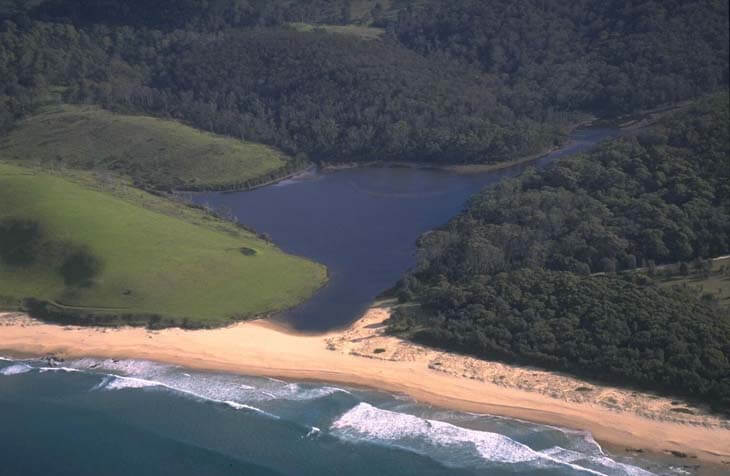Bunga Lagoon is located on the far south coast of New South Wales. This estuary is classed as a small lagoon with an intermittently closed entrance. Brockelos Creek is a main tributary to the lagoon.
Water quality report card
As part of our water quality monitoring program we assess the water quality and ecosystem health of an estuary using a range of relevant indicators. We sample a subset of the estuaries between Wollongong and the Victorian border every 3 years. The most recent sampling in Bunga Lagoon was completed over the 2011–12 summer, when 2 sites were sampled on a monthly basis.
This report card represents 2 water quality indicators that we routinely measure: the amount of algae present and water clarity. Low levels of these 2 indicators equate with good water quality.
Algae
Water clarity
Overall grade
The report card shows the condition of the estuary was excellent with:
- algae abundance graded excellent (A)
- water clarity graded good (B)
- overall estuary health graded excellent (A).
Grades for algae, water clarity and overall are represented as:
- A – excellent
- B – good
- C – fair
- D – poor
- E – very poor.
Go to estuary report cards to find out what each grade means, read our sampling, data analysis and reporting protocols, and find out how we calculate these grades.
Physical characteristics
| Estuary type | Lagoon |
|---|---|
| Latitude | –36.54 (ºS) |
| Longitude | 150.06 (ºE) |
| Catchment area | 11.5 km2 |
| Estuary area | 0.1 km2 |
| Estuary volume | 40.9 ML |
| Average depth | 0.4 m |
Notes: km2 = square kilometres; m = metres; ML = megalitres.
Water depth and survey data
Bathymetric and coastal topography data for this estuary are available in our data portal.
Land use
About 85% of the catchment of Bunga Lagoon is forested and about 10% of the catchment is used for grazing.
National and marine parks
- Mimosa Rocks National Park is the largest conservation area in the Bunga Lagoon catchment.
- This estuary does not flow into a marine park.
Citizen science projects
- The Far South Coast Conservation Management Network supports the local community to better manage native biodiversity. The network organises citizen science projects, provides information for private landowners, manages a local plant database, and coordinates events.
Community involvement
- The Bega River and Wetlands Landcare Group is a volunteer group dedicated to improving the health of the Bega River, wetlands and floodplains.
- The Far South Coast Landcare Association is a volunteer environmental and conservation organisation that works to improve management of local land and water.

Aerial view of Bunga Lagoon estuary.
Local government management
Local councils manage estuaries within their area unless the estuary is attached to a marine park.
Bega Valley Shire Council manages this estuary.
Threatened species
Bunga Lagoon is home to coastal saltmarsh, an endangered ecological community that occurs in the intertidal zone between land and the sea. Intermittently flooded by the tides, the coastal saltmarsh habitat supports a range of plants and animals.
Find out more about the biodiversity in our estuaries.